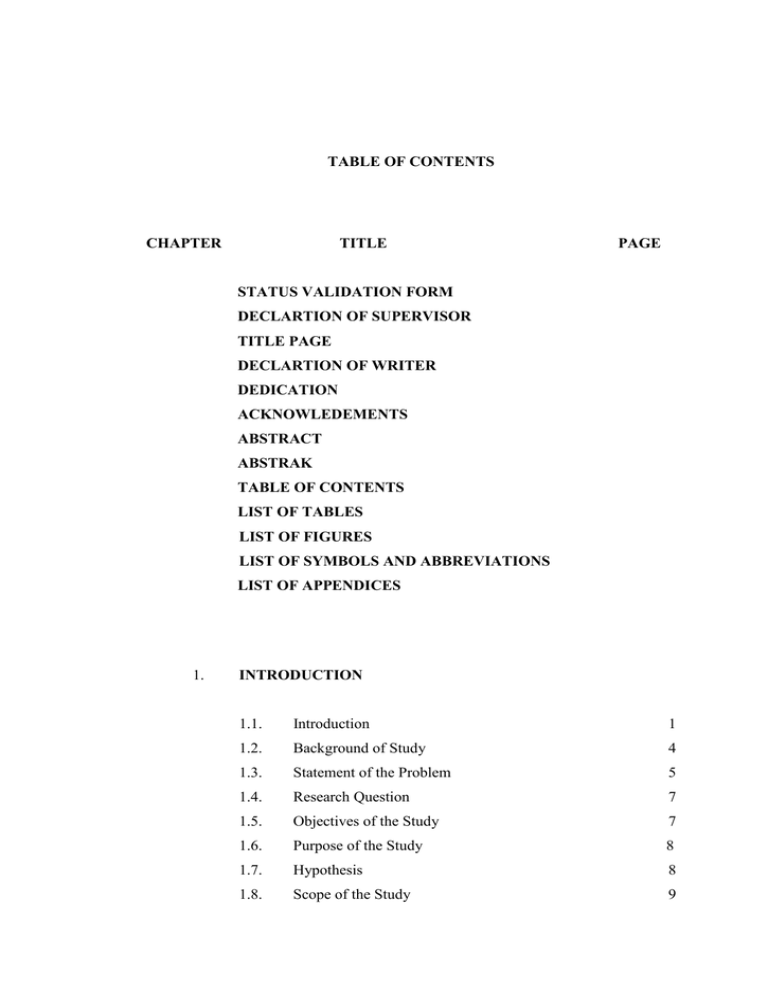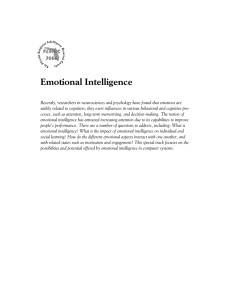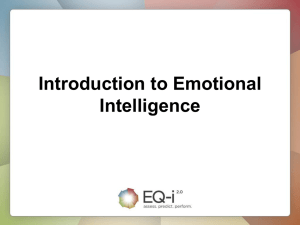TABLE OF CONTENTS CHAPTER TITLE
advertisement

TABLE OF CONTENTS CHAPTER TITLE PAGE STATUS VALIDATION FORM DECLARTION OF SUPERVISOR TITLE PAGE DECLARTION OF WRITER DEDICATION ACKNOWLEDEMENTS ABSTRACT ABSTRAK TABLE OF CONTENTS LIST OF TABLES LIST OF FIGURES LIST OF SYMBOLS AND ABBREVIATIONS LIST OF APPENDICES 1. INTRODUCTION 1.1. Introduction 1 1.2. Background of Study 4 1.3. Statement of the Problem 5 1.4. Research Question 7 1.5. Objectives of the Study 7 1.6. Purpose of the Study 8 1.7. Hypothesis 8 1.8. Scope of the Study 9 1.9. Significance of the Study 10 1.10. Limitation of the Study 11 1.11. The Conceptual Definition 12 1.11.1. Team 12 1.11.2. Team member 12 1.11.3. Team Work 13 1.11.4. Team performance 13 1.11.5. Nurse 13 1.11.6. Nursing 14 1.11.7. Emotion 15 1.11.8. Emotional Intelligence 15 1.12. 2. Operational Definition 16 1.12.1. Team performance 17 1.12.2. Emotional Intelligence 17 1.12.2.1. Optimism/Mood Regulation 17 1.12.2.2 Appraisal of Emotions 18 1.12.2.3 Social Skills 18 1.12.2.4 Utilization of Emotions 18 LITERATURE REVIEW 2.1. Introduction 20 2.2. Emotion 20 2.3. Emotional Intelligence 22 2.4. 2.3.1. Ability Emotional Intelligence 24 2.3.2. Trait Emotional Intelligence 24 Models of Ability and Trait Emotional Intelligence 25 2.4.1. Ability Emotional Intelligence Models 25 2.4.1.1 A Three-component Model of Emotional Intelligence 26 2.4.1.2 The Four-Branch Model of Emotional Intelligence 27 2.4.2 Trait Emotional Intelligence Models 30 2.4.2.1. Emotional Social Intelligence (ESI) Model 30 2.4.2.2 Emotional Quotient Inventory (the EQ-i) 2.5. 2.6. The Four Sub-factors of Individual Emotional Intelligence 34 2.5.1. Optimism/Mood Regulation 34 2.5.2. Appraisal of Emotions 35 2.5.3. Social Skills 35 2.5.4. Utilization of Emotions 36 Team Mental Models Relate with Team Performance 37 2.6.1. Shared Mental Models 37 2.6.1.1. Types of Shared Mental Model 2.6.2. Taskwork and Team Work Mental Models 38 40 2.6.2.1. Taskwork Mental Models 40 2.6.2.2. Teamwork Mental Models 41 2.6.3. Emotions within Nursing 2.7. 31 42 Individual Emotional Intelligence, Team Performance and Nursing Team Performance 43 2.7.1. Individual Emotional Intelligence and Team Performance 43 2.7.2. Individual Emotional Intelligence and Nursing Team Performance 2.7.2.1. 44 Optimism/Mood Regulation and Nursing Team Performance 2.7.2.2. Appraisal of Emotions and Nursing Team Performance 2.7.2.3. 47 Social Skills and Nursing Team Performance 2.7.2.4. 45 47 Utilization of Emotions and Nursing Team Performance 49 2.8. Pervious Related Studies 50 2.9. Summary 52 3. METHODOLOGY 3.1. Introduction 55 3.2. Research Design 55 3.3. Research Population and Sampling 57 3.3.1. Research Population 57 3.3.2. Research Sampling 60 Data Collection 61 3.4.1. Primary Data 62 Research Instrument 62 3.5.1. Research Questionnaire 63 3.4. 3.5. 3.5.1.1. Part A: Demographic Information 3.5.1.2. Part B: Self-report Emotional 3.5.1.3. 3.6. 3.7. 3.8. 4. 64 Intelligence Scale 64 Team Performance 66 Pilot Test 67 3.6.1. Reliability 68 Data Analysis 70 3.7.1. Descriptive Statistics 70 3.7.2. Inferential Statistics 72 3.7.2.1. Person Correlation Analysis 72 3.7.2.2. Multiple Regression Analysis 73 Summary 74 DATA ANALYSIS 4.1. Introduction 76 4.2. Profile of Nurses 77 4.2.1. Gender 77 4.2.2. Age 77 4.2.3. Length of Service 78 4.2.4. Position 79 4.2.5. Salary 79 4.3. Reliability Analysis 80 4.4. Descriptive Statistics 81 4.4.1. Individual Emotional Intelligence (EI) 81 4.4.1.1. Optimism/Mood Regulation 82 4.4.1.2. Appraisal of Emotions 83 4.4.1.3. Social Skills 85 4.4.1.4. Utilization of Emotions 86 4.4.2. Nursing Team Performance 4.5. 4.6. 4.7. 4.8. 5. 87 Relationships Between Individual Emotional Intelligence (EI) and Nursing Team Performance 89 Testing the Assumptions of Multiple Regression Analysis 93 4.6.1. Normality of the Distribution 93 4.6.2. Linearity of the Relationship 94 4.6.3. Multicollinearity 95 4.6.4. Homoscedasticity or independence of the errors 95 Which Individual Emotional Intelligence (EI) Sub-Factors Contribute to Nursing Team Performance 96 Summary of Data Analysis 98 CONCLUSION 5.1. Introduction 100 5.2. Findings and Discussion 101 5.2.1. The Level of Individual Emotional Intelligence (Optimism/Mood Regulation; Appraisal of Emotions; Social Skills and Utilization of Emotions) Among Nurses 102 5.2.1.1. Optimism/Mood Regulation 102 5.2.1.2. Appraisal of Emotions 103 5.2.1.3. Social Skills 104 5.2.1.4. Utilization of Emotions 104 5.2.2. The Level of Nursing Team Performance 105 5.2.3. The Most Strongly Contribute Sub-Factors to Nursing Team Performance 5.3. Recommendations 106 109 5.3.1. Recommendations for Hospitals or Organizations 109 5.4. 5.3.2. Recommendations for Future Study 111 Conclusion 112 REFERENCES 114 APPENDICES A 127 APPENDICES B 133 APPENDICES C 135 LIST OF TABLE TABLE NO. TITTLE PAGE 2.1 The Four-Branch Model of Emotional Intelligence 29 2.2 The EQ-i Scales and What They Assess 32 2.3 Summarizes The Types of Shared Mental Models 39 2.4 Taskwork and Teamwork Mental Models in A Team 41 2.5 Research Framework 53 3.1 The Distribution of 680 Nurse 58 3.2 384 Respondents’ Personal Divisions 61 3.3 Components of Questions 64 3.4 The Determinants Influencing Individual Emotional Intelligence 65 3.5 Likert Scale Question 67 3.6 Alpha Cronbach Reliability Range 69 3.7 Summary of Reliability Test 69 3.8 The Mean Score 72 3.9 Classification of Pearson Correlation Values(r) 73 3.10 Data Analysis Methods Used on Objectives of This Study 74 4.1 The Distribution of Frequency and Percentage by Gender 77 4.2 The Distribution of Frequency and Percentage by Age 78 4.3 The Distribution of Respondent’s Period of Service 79 4.4 The Distribution of Frequency and Percentage by Position 79 4.5 The Distribution of Frequency and Percentage by Position 80 4.6 Summary of Reliability Test 81 4.7 Descriptive Statistics on “Optimism/Mood Regulation” 82 4.8 Descriptive Statistics on “Appraisal of Emotions” 84 4.9 Descriptive Statistics on “Social Skills” 85 4.10 Descriptive Statistics on “Utilization of Emotions” 87 4.11 Descriptive Statistics on “Nursing Team Performance” 88 4.12 Correlations between Individual Emotional Intelligence (EI) and Nursing Team Performance 90 4.13 Skewness and Kurtosis Value 94 4.14 Collinearity for Nursing Team Performance as the Dependent Variable 95 4.15 Summary of Multiple Regressions between Nursing Team Performance and 4.16 Individual EI Sub-Factors 96 Summary of Research Hypotheses 99 LIST OF FIGURES FIGURE NO. 3.1 TITLE Follow of Methodology of Research PAGE 56 LIST OF SMYBOLS AND ABBREVIATIONS EI - Emotional Intelligence IEI - Individual Emotional Intelligence OMR - Optimism/Mood Regulation AoE - Appraisal of Emotions SS - Social Skills UoE - Utilization of Emotions NTP - Nursing Team Performance LIST OF APPENDICES APPENDIX TITLE PAGE A Questionnaire (English) 128 B Linearity Graphical Plots 133 C Homoscedasticity Plot 135


